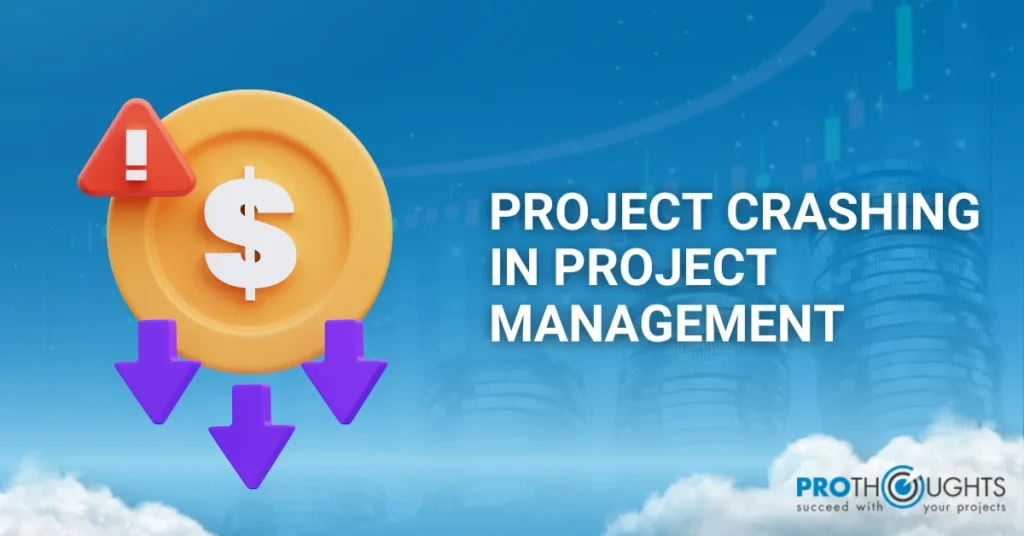Complying with deadlines and ensuring all tasks are done on time is critical. A major component of a project manager’s day-to-day duties is dealing with a tight schedule, unforeseen delays, and pushes to accelerate project completion without compromising quality. This is where the concept of “Project crashing in project management” comes into play.
In this blog, we’ll explore how mastering this technique can help you ace your PMP exam. From understanding the critical path to prioritizing crashing efforts, conducting cost-benefit analysis, and effectively communicating with stakeholders, we’ll cover everything you need to know to become proficient in project crashing and excel in your project management career.
So, let’s dive in and unlock the secrets of project crashing a key strategy that can propel your projects to success and pave the way for your PMP certification journey.
What is Project Crashing?
In project crashes, project managers expedite completion without compromising quality or scope. It corresponds to the purposeful sparing of some resources for the fast-track plan of action in the critical path activities to bring their duration down and the whole project time way ahead. Moreover, the critical path is the sequence of activities that eventually specify the minimum time required for the project to be completed. By focusing their efforts on the most important activities of the path, project managers will able to minimize the project duration.
Subsequently, the procrastinating project typically demands situations where there is a need to complete the project after originally planned or when the project is going behind schedule and needs to be rushed to meet the deadline. Industries with time-critical projects, such as construction, engineering, and event management, frequently use the just-in-time method, which requires stocks and resources to arrive just before consumption.
What are the Objectives of Project Crashing?
Organizations accelerate projects primarily to meet deadlines imposed by external factors such as client requirements, contract obligations, or market demand. It is to shorten the general length of the project as a whole by speeding up the duration of the key nodes that are in the critical path. This enables completing the project earlier than the planned schedule. Besides, the collapsing time critical path activities minimizes the project delay risk and allows the project to be on time, preventing any unpredictable events or changes from happening. Wrapping up the statement, time-bound deliverables to stakeholder satisfaction include service users, funder, and project team members.
What are the four steps to Project Crashing?
- Identify Critical Path – The initial step in project fast-tracking is identifying critical paths through proper task sequence looking and their dependencies using the Critical Path Method or the Program Evaluation and Review Technique.
- Identify Crashable Activities – Afterward, project managers must identify critical path activities to crash by allocating additional resources.
- Estimate Crash Costs – Project managers estimate the additional cost for crashing the activities factoring in the costs like labor costs, equipment rental fees, and other unexpended funds by giving priority to completing the task early.
- Select Crashing Options – Considering the calculated crash costs and preferred time decrease in project duration, project managers find the best alternative that significantly reduces project cost and duration. Hence, for instance, this shall require allocating more resources, adjusting labor schedules, or letting out some of the assignments to vendors who specialize in a field.
Consequently, since those steps are implemented, project managers will be able to crash the schedule of the project into being shortened at the expense of some time-limited resources among the three constraints of schedule, cost, and quality. Hence, we need to follow up on crashed tasks closely and evaluate the course of the project as we proceed to make sure we will achieve our goal.
Techniques and Methods of Project Crashing
Project crashing involves several techniques and methods focused on taking the duration of the project while the project quality and scope are kept. These measures are instrumental to the functioning of the best project management tools, particularly in the event of a highly demanding schedule within a breach of the time frame or the responsive approach to changing project requirements. The subsequent are the fundament skills often involved in project crashing projects.
1. Critical Path Method (CPM)
A critical path algorithm aims to find the longest sequence of connected tasks, known as a critical path. It is the sequence of tasks that determines the shortest possible duration for completing the project. Furthermore, the critical path entails the sequence of tasks that will happen consecutively and timely to maintain the deadlines of the entire project. That way, project managers can type in the main tasks for a project completion on time leaving a sufficient reserve of resources and effort for tasks that are urgent to start with.
2. Program Evaluation and Review Technique (PERT)
Another PERT Plan and evaluation technique is to plan and estimate the amount of work and tasks that are needed for the success of a project. The team estimates the duration of each task by considering a weighted average time, taking into account uncertainties and variability in task durations. Furthermore, PERT has the effect of spotlighting time-critical tasks and checking project risk management, reducing uncertainties, and enabling accurate planning as well as resource allocations for project implementation.
3. Fast Tracking
Management employs acceleration as a technique to expedite project schedules continuously, focusing on tasks and phases rather than intermittently. In contrast to one task before putting the next one on hold, fast-laning involves parallel execution of activities that allows to conduction of overlapping work, thus cutting the overall period. Although adopting fast-track production increases project schedules, it may cause some problems with project risks and dependencies which consequently can lead to worse outcomes unless made clear.
Moreover, all of the above cells provide the project wrapping with different advantages and difficulties, which makes the project manager apply several of them in a particular situation varying in the requirements and restrictions Through knowledge and strategic implementation of these techniques, project managers can maintain efficient project schedules, facilitate the minimization of risks, and grow to become major contributors to wink project success even in ever-changing and tough environments.
Factors Influencing Project Crashing
1. Time Constraints
A deadline is a time limit or a project completion time frame to which a project must adhere. The constraints may vary simultaneously, as they depend on conditions like contract obligations, which can also serve as market requirements or regulations. Usually results in project crashing because of the need to finish projects prematurely due to the shifts in required delivery times or the project scope management. To complete with serious time limitations, project managers can introduce the project crashing techniques into the project which will result in the required duration of the project shortening, so the project completion will not negatively impact quality.
2. Resource Availability
Resource Management speaks of workforce availability, equipment for the project, and other materials that the project needs to accomplish activities and tasks required. Unavailability of resources may affect the project schedules and deadlines, resulting in the timestamp advent and links can consequently emerge. Also, in project crashes, the resource gap and its way to the planning and implementation of the crashing strategy is very crucial. Adequate resource availability is essential for implementing crashing options such as adding additional manpower or equipment to expedite critical path activities. However, resource constraints may limit project crashing, requiring careful resource management.
3. Cost Considerations
Cost considerations involve assessing the additional costs associated with implementing project crashing strategies. Emergency actions usually, if not always, mean that new resources are poured in such as hiring more labor, renting equipment, or even delivery speed-ups that will result in greater expenditures. Managers of projects must make estimations about the efficiency of crashing that they can do by comparing savings from shorter times of projects with the additional cost of crashing the activities. Also, Cost considerations include assessing the potential impact of crashing on overall project budgets and financial resources. Therefore, effective cost management is essential to ensure that project crashing remains within budgetary constraints.
4. Stakeholder Priorities
Stakeholder priorities encompass aims, goals, and objectives held by project participants, influencing project vitality, objectives, and constraints for crashing decisions. For example, clients prioritize timely project delivery to meet market demands, while project-team members focus on resource optimization and workload management. In addition, identifying stakeholders’ priorities aligns project crashing strategies with expectations and targets, crucial for goal attainment. Moreover, Close collaboration and communication with stakeholders are essential to address concerns and resolve conflicting priorities effectively.
Nevertheless, the project managers taking these factors into account, namely the schedule time limitations, the resource availability, the cost considerations, and the stakeholder priorities, can develop the options and implement the strategies that can not only accelerate the project schedule but also meet the project goals and the expectations of stakeholders. To successfully crash projects, planners must measure progress and strike the right balance of cost, time, and quality in planning.
Conclusion
It is a critical tool in the project manager’s toolkit, offering a way to meet tight deadlines and navigate unexpected challenges effectively. To ensure timely completion, project managers must allocate resources strategically and manage critical tasks. So, Ready to elevate your project management skills and learn more about these techniques? Enroll today in our comprehensive project management course!

